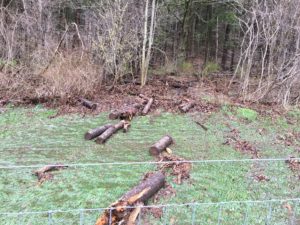Long time readers will recall that we installed a geothermal heating system to replace our old heating oil furnace.
Here are a few more details about the geothermal thermal system and the installation process.
A geothermal heating and cooling system is essentially a heat pump system that uses the relatively constant temperature underground to move heat from one place to another. The systems are also sometimes called ground source heat pumps. In the winter, the system pulls heat from the ground and moves it into the house. In the summer, such a system can move heat from the house to the ground. Because our house does not have air ducts and instead relies on baseboard hot water radiators, our system is currently set up only for heating, though the ground loops and the heat pump can be used for cooling in the future if we make a few changes inside the house.
Our system is a closed loop system – meaning water (plus a type of antifreeze) is circulated in a loop of piping from the house to wells underground and then back up to the house to start the loop over.
Our installers used a specialized German drilling rig that can fit in tighter spaces compared to some truck based drilling rigs. It was able to move right into place in the backyard for drilling.
















